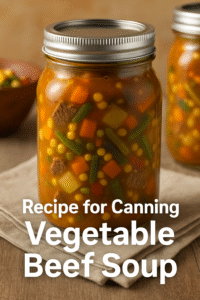Table of Contents
ToggleRecipe for Canning Vegetable Beef Soup
Canning vegetable beef soup is one of the best ways to preserve hearty, nutritious meals that can be enjoyed anytime. Whether you are preparing for the winter season, stocking your pantry, or simply love the idea of homemade, ready-to-eat soup, this guide will walk you through the perfect recipe for canning vegetable beef soup. With the right ingredients, proper methods, and attention to detail, you can safely can delicious soup that maintains its flavor, texture, and nutrients.
Home-canned soups offer convenience and comfort. Instead of relying on store-bought, preservative-laden options, you can enjoy your own wholesome recipe made exactly to your taste. Vegetable beef soup is particularly ideal for canning because it combines protein, vegetables, and broth in one satisfying meal. This article provides a complete, safe, and delicious recipe for canning vegetable beef soup at home.
Why Choose Vegetable Beef Soup for Canning
Vegetable beef soup is not only filling but also packed with essential nutrients. The combination of tender beef, garden-fresh vegetables, and savory broth creates a meal that is both delicious and nourishing. When canned properly, it retains its rich flavor and long shelf life, making it an excellent choice for home food preservation.

The variety of ingredients also allows for flexibility. You can use seasonal vegetables, leftover cuts of beef, and customize the flavors to suit your family’s preferences. Additionally, having home-canned vegetable beef soup in your pantry is a time-saver on busy days when cooking from scratch isn’t possible.
Essential Ingredients for Canning Vegetable Beef Soup
To prepare a safe and flavorful batch of canned vegetable beef soup, you need high-quality ingredients. Always use fresh vegetables, lean cuts of beef, and clean, sterilized canning jars to ensure the best results. Avoid ingredients like pasta, rice, or dairy products in your canned soup, as these do not preserve well during the pressure canning process.
Common vegetables for this recipe include carrots, potatoes, green beans, peas, celery, corn, and tomatoes. For the beef, opt for stew meat, chuck roast, or other tender cuts suitable for slow cooking. You will also need beef broth, water, salt, and spices such as bay leaves, black pepper, and thyme to enhance the flavor of the soup.
Preparing the Soup for Canning
The first step is to thoroughly wash and peel all vegetables. Chop them into uniform, bite-sized pieces to ensure even cooking and consistent texture in the finished soup. Cut the beef into small cubes and trim off any excess fat to avoid spoilage during storage.
In a large stockpot, brown the beef over medium heat until it is fully cooked and slightly caramelized. This adds depth of flavor to the soup. Remove the beef from the pot and set it aside. In the same pot, sauté onions, garlic, and celery until fragrant and softened.
Next, return the beef to the pot and add the remaining vegetables. Pour in the beef broth and enough water to create the desired consistency of your soup. Season the mixture with salt, pepper, bay leaves, and any other herbs you enjoy. Bring the soup to a gentle boil and simmer for 10 to 15 minutes. This step partially cooks the ingredients without fully softening them, which helps maintain their texture after the canning process.
How to Safely Can Vegetable Beef Soup?
Canning vegetable beef soup requires the use of a pressure canner. Low-acid foods like meat and most vegetables must be pressure canned to eliminate the risk of botulism and ensure food safety. Never attempt to can this recipe using a water bath canner, as it is not safe for soups containing meat or low-acid vegetables.
Begin by sterilizing your canning jars, lids, and bands in hot soapy water. Rinse them well and keep them warm until ready to use. Prepare your pressure canner according to the manufacturer’s instructions.
Ladle the hot soup into the jars, leaving one inch of headspace at the top. This space allows for expansion during the canning process. Remove any air bubbles by gently running a spatula or knife around the inside edge of the jar. Wipe the rims with a clean, damp cloth to ensure a proper seal.

Place the lids and bands on the jars, tightening them to fingertip tightness. Arrange the jars inside the pressure canner, following the recommended spacing and water level guidelines.
Process the jars at the correct pressure and time based on your altitude. Typically, vegetable beef soup is canned at 10 to 11 pounds of pressure for 75 minutes for pint jars and 90 minutes for quart jars. Always consult your pressure canner manual and trusted canning guidelines to confirm exact times and pressures for your location.
Cooling, Storing, and Checking Your Canned Soup
After processing, allow the pressure canner to cool naturally before opening it. Carefully remove the jars using a jar lifter and place them on a towel or cooling rack. Let them sit undisturbed for 12 to 24 hours.
Once the jars have cooled, check the seals by pressing the center of each lid. If the lid does not flex or pop, the jar is sealed properly. Any unsealed jars should be refrigerated and used within a few days.
Label your jars with the contents and date. Store them in a cool, dark place such as a pantry or basement. Properly canned vegetable beef soup can last for up to 12 to 18 months while maintaining its best quality.
Tips for the Best Canned Vegetable Beef Soup
For the best flavor and safety, always use fresh, high-quality ingredients and follow approved canning procedures. Avoid overcooking the soup before canning, as it will continue to cook during the pressure canning process.
Do not add ingredients like dairy, flour, rice, pasta, or thickeners to your soup before canning. These can interfere with heat penetration and compromise the safety of the final product. If you prefer a thicker soup, you can add these ingredients when reheating the soup before serving.

Experiment with different vegetables and seasonings to create a version of vegetable beef soup that suits your taste. Just remember to keep the overall balance of ingredients safe for canning, using reliable recipes and guidelines.
Benefits of Canning Your Own Soup
Canning vegetable beef soup at home offers numerous benefits beyond convenience. It allows you to control the ingredients, ensuring there are no unwanted additives or preservatives. Homemade soup is often healthier and more flavorful than store-bought versions.
Canned soups are ideal for emergency preparedness, as they provide ready-to-eat meals that require minimal preparation. Having jars of vegetable beef soup in your pantry saves time on busy days and provides comfort food during cold weather or illness.
Canning also reduces food waste by preserving seasonal vegetables and meat that might otherwise spoil. You can create large batches of soup when ingredients are abundant and enjoy them throughout the year.
Frequently Asked Questions About Canning Vegetable Beef Soup
How long does home-canned vegetable beef soup last
Properly canned vegetable beef soup can last up to 18 months when stored in a cool, dark, and dry place. For the best flavor and texture, it is recommended to consume the soup within one year. Always inspect jars for signs of spoilage, such as bulging lids, leaks, or off odors, before consuming.
Is it safe to can vegetable beef soup with potatoes
Yes, it is safe to can vegetable beef soup with potatoes, provided you follow approved pressure canning methods. Cut the potatoes into small, uniform pieces to ensure even heat penetration. Using waxy potatoes such as red or Yukon gold varieties helps maintain texture during canning.
Can I thicken my vegetable beef soup before canning
It is not recommended to thicken soup before canning. Ingredients like flour, cornstarch, or other thickeners can prevent proper heat circulation inside the jars, increasing the risk of spoilage. You can thicken the soup after opening the jar and reheating it for serving.
Why can’t I use a water bath canner for vegetable beef soup
Vegetable beef soup contains low-acid ingredients and meat, which require higher temperatures to destroy harmful bacteria like Clostridium botulinum. A water bath canner cannot reach the necessary temperatures for safe preservation. Only a pressure canner should be used for canning this type of soup.
What should I do if a jar didn’t seal properly
If a jar of soup did not seal properly after canning, refrigerate it and use the contents within three to five days. Do not attempt to reprocess the jar, as this may compromise the quality of the soup. Always check seals after cooling to ensure your canned goods are safe for storage .
Here are suggested outbound links you can naturally include in your article “Recipe for Canning Vegetable Beef Soup” to improve SEO and user experience:
Example Outbound Links Placement
In the section “How to Safely Can Vegetable Beef Soup,” you can add:
For detailed pressure canning guidelines, visit the National Center for Home Food Preservation.
In the section “Benefits of Canning Your Own Soup,” you can add:
Learn more about the health benefits of homemade soups from Healthline.
In the FAQs section under “Is it safe to can vegetable beef soup with potatoes,” you can add:
For more safe canning recipes using potatoes, refer to USDA’s Complete Guide to Home Canning.
Would you like me to revise your full article text with these outbound links inserted naturally?
Conclusion
Canning vegetable beef soup is a rewarding way to enjoy homemade, wholesome meals throughout the year. With the right ingredients, careful preparation, and proper pressure canning techniques, you can safely preserve delicious soup that is ready to eat whenever you need it. Following approved guidelines ensures both safety and quality, providing peace of mind and convenience for your family.
By mastering this recipe for canning vegetable beef soup, you take an essential step toward food security, reduced waste, and culinary satisfaction. Start your home canning journey today and enjoy the rich, comforting flavors of vegetable beef soup anytime.